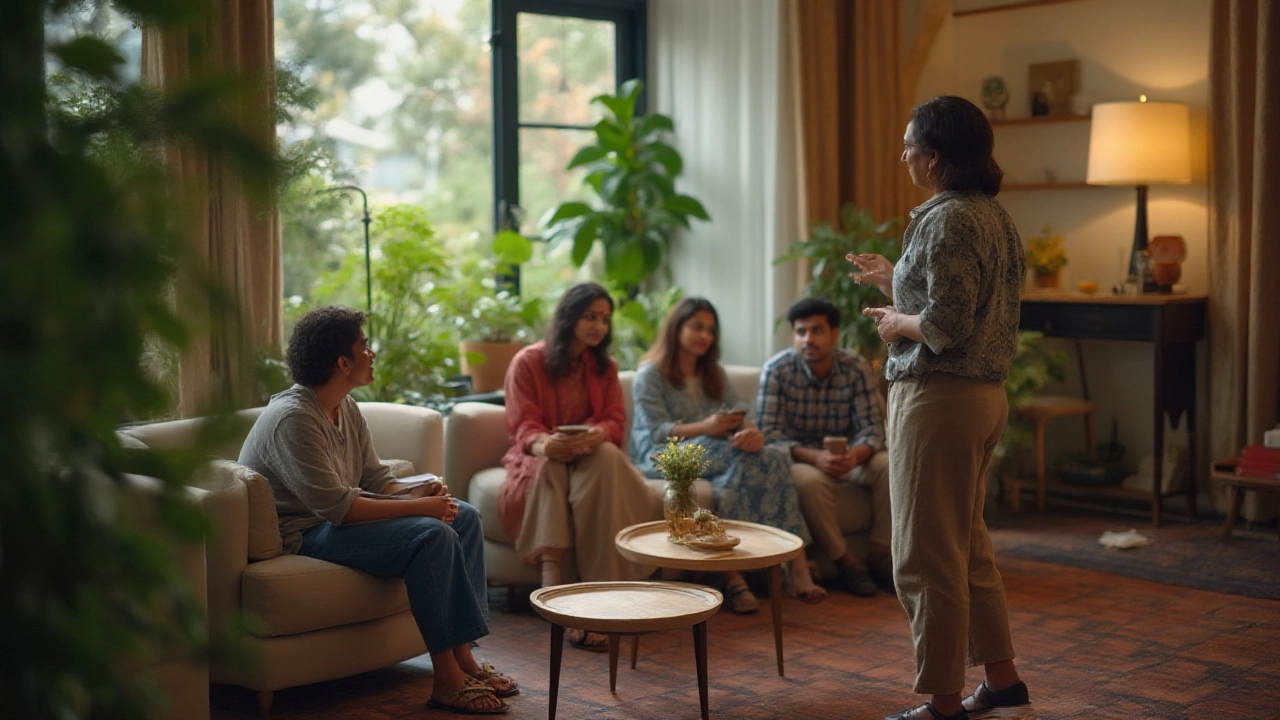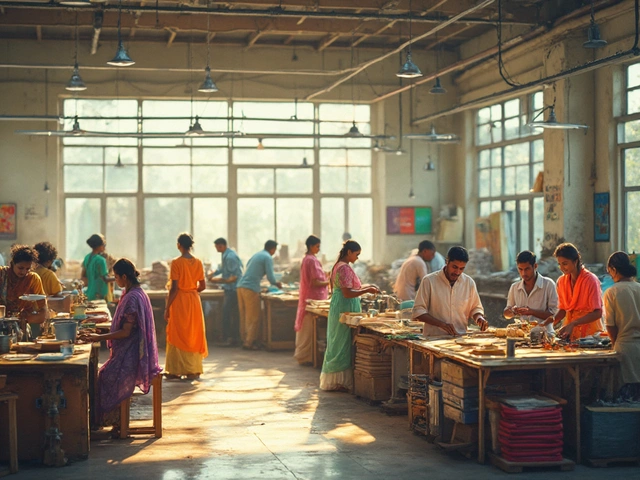The iced coffee crowd used to think India’s furniture game was just carved wooden antiques from grandpa’s attic. Forget that. Right now, factories from Jaipur to Chennai are buzzing, and Indian furniture isn’t just for India anymore—millions of desks, beds, chairs, and designer sofas are shipped worldwide. Thanks to a surge in home makeovers and a rising middle class hooked on Pinterest and Instagram, the furniture industry in India hit some serious milestones in 2024. Here’s the story of how the world’s most dynamic furniture hub keeps reinventing itself.
India’s Furniture Market in 2024: Numbers, Players, and What Changed
Picture entering a local furniture bazaar in Delhi in the 1990s. “Solid Sheesham wood, sir! Handmade.” Fast forward to August 2024, and you’ll still see the skilled local carpenters, but they’re sharing billing with sleek modular designs, imported panels, and smart tech-enabled showrooms. India’s furniture industry roared past the $34 billion mark this year, making it one of Asia’s top furniture markets. Exports reached over $2.4 billion, climbing 12% from 2023 (as per industry tracking site Statista). What’s behind the numbers?
First off, there’s the growing appetite for stylish, affordable furniture among India’s huge young population—over 50% of Indians are under 30. City living means smaller rooms, so space-saving and multi-use furniture lined up with urban apartments. Ikea, Godrej Interio, Zuari, and Pepperfry kept rolling out new lines, and this year saw global names like West Elm and Muji boosting their local sourcing. Demand for custom modular wardrobes and beds basically exploded, with customers wanting furniture that fits funky-shaped rooms and goes up in a day—no big hammers needed.
But don’t think it’s all chain stores. Artisan clusters from Saharanpur, Jodhpur, and Kerala kept giving India its edge in wooden furniture—teak and mango wood continue to star in both premium and affordable ranges. The eco-friendly trend also grew louder; more startups promoted recycled wood, bamboo, and resin-based products, sometimes blending them for hybrid designs. Government initiatives like the Production Linked Incentive (PLI) schemes for furniture got real in 2024, giving tax breaks to companies using renewable materials.
One thing grabbing headlines: furniture’s digital makeover. In 2024, about 40% of all furniture sales in India happened online—double what it was right before the pandemic. Brands like Urban Ladder, Wakefit, and Livspace set up virtual reality (VR) tools so you could visualize a new sofa in your actual living room, no awkward tape-measuring needed. Even rural artisans figured out how to run WhatsApp ‘furniture stores’ for direct customer sales.
It hasn’t been all smooth sailing, though. Indian pine and teak prices jumped nearly 30% since late 2023 because of land use changes and unpredictable monsoon seasons. To keep prices in check, some companies invested in engineered wood and recycled materials from construction sites. Crowdfunding and small-scale financing platforms let local entrepreneurs launch their own furniture brands, sparking a wave of “Indie” furniture—imagine your corner coffee table with a QR code that links to its carpenter’s workshop story. Authenticity sells, both in India and abroad.

Trends Shaping Indian Furniture Styles and Production in 2024
Flip open any design magazine this year, and you’ll see that ‘Indian Modern’ is the leading vibe—clean lines, warm colors, a hit of rattan or cane here and there. Wabi-sabi, Japandi, and Mediterranean influences all made their way onto Indian floors, but people craved the cozy, personal touch too. The idea is—make it special, but make it comfortable. The “do-it-yourself” (DIY) movement also moved beyond memes. DIY repair kits for furniture, easy-assemble pieces, and upcycling workshops at big retailers made home improvement less intimidating for everyday folks.
The push for sustainability wasn’t just buzz. Homeowners and businesses asked questions like: “Was this teak legally sourced?” “Does this table use chemical-free polish?” Big brands had to publish supply chain information right on their product pages. A few—like Saraf Furniture and WoodenStreet—adopted blockchain tech to show real-time Wood Origin Tracking, a first for the Indian market. Other companies invested in water-based finishes, coconut fiber panels, and locally crafted hardware, which made for lightweight, lower-carbon-footprint furniture.
Another game changer? Customization at scale. Previously, “custom” furniture meant haggling with a neighborhood carpenter or paying through the nose. In 2024, tech platforms let you tweak colors, shapes, handles—sometimes with a smartphone app. Pepperfry even rolled out a SnapShop AI tool that analyzes your room selfie and suggests furniture shapes that fit your actual space (and no, it doesn’t try to push you a 12-foot sofa for a studio). Hospitality and coworking spaces took advantage of this, too, ordering bulk-custom lines for new hotels and offices in record time.
And let’s not forget the rural-urban crossover. Cane and bamboo furniture, once seen as either “traditional” or “cheap,” reemerged in urban fancy homes, cafes, and hotels. Kerala’s artisans kept busy weaving chairs that Instagram made iconic, while design schools in Mumbai and Bengaluru held summer programs in upcycling, inviting international collaboration. There’s also a slow but steady demand for ergonomic furniture, thanks to long hours spent on home office setups. Back-pain-friendly mesh chairs, height-adjustable tables, and minimalist work pods pulled in buyers who don’t want their homes looking like soulless cubicles.
Keep an eye on 3D printing—yes, it’s here. A startup in Pune rolled out limited edition stools and lamp bases using recycled plastic granules. The crowd loved it. Meanwhile, companies started using AI-driven inventory management tools to cut storage losses, reduce cost, and send finished pieces straight from the workshop to your door—no dusty warehouses. Even logistic giants like Delhivery and Blue Dart got into the action, with furniture-special transport units, solving the ‘damaged-in-transit’ problem for bulky pieces.

Tips for Buyers, Sellers, and Aspiring Furniture Entrepreneurs in India
Thinking about opening a furniture store, buying new furniture, or even launching your own creations? There’s plenty to learn from what’s hot and what isn’t in 2024. For buyers, the smart thing is to check the product story before you buy. Ask: Is this made from solid wood or engineered sheet? Is the polish child-safe? Can the company show its raw material sourcing? Don’t be afraid to hunt for indie brands whose pieces last longer than trendy “fast furniture.”
If you’re buying online, try the new AR and VR tools most big platforms offer. Place that sofa or bed digitally in your home before you commit. Many showrooms now have home consultation services—sometimes free if you order—that’ll help you avoid the “my couch didn’t fit the door” drama. Also, some sellers offer “upcycling buyback,” where they take your old table or chair, refurbish it, and knock money off your next purchase. Care about longevity? Look for joinery construction (like mortise-and-tenon joints) instead of “just glue and screws.”
Sellers, this is the year mixed material designs took off—meaning wood with metal, glass with resin, even plastic with woven jute. Don’t just push plain old dark brown furniture. Bright, bold colors and finishes are in. Collaborate with local designers and artisans for unique items. Seriously—nobody wants cookie-cutter stuff anymore. Build your online showcase, but don’t ignore live events. Pop-up stores, home design fairs, and artisan markets create buzz for your brand.
Aspiring furniture makers? Start small—think a signature coffee table, compact bookshelf, or multi-use bench—and tell the product’s backstory with great photos and real video. Social media is a must; Instagram Reels or WhatsApp stories work better than spending a fortune on print ads. Get registered on e-commerce platforms and try using crowdfunding sites for custom or limited edition ideas. Learn the ropes on sustainable sourcing. Fact: The best customer review you’ll ever get is “lasted longer than expected.” So, invest in quality hardware and finishes.
And a biggie—don’t ignore regulations. Legal standards for fire safety, chemicals in polish, and worker conditions are under the scanner. In 2024, the Indian government rolled out stricter rules for labeling materials and compliance. If you want to export, check for international certifications like FSC (Forest Stewardship Council) for wood, or BIFMA for office chairs.
Tip for everyone: If you love a piece, ask how it’s maintained. Some beautifully finished tables or cabinets look great but need regular touch-ups. A shop that offers after-sales care or repair services stands out from the crowd. And if you care about the planet, support businesses that use reclaimed wood and low-VOC paint, or locally sourced materials, shrinking that supply chain footprint.
So whether you’re redecorating, growing a startup, or just chasing inspiration for your studio apartment, India’s furniture industry in 2024 is more lively—and way more creative—than ever. Try out new textures, support local makers, and always make your home your own. Just keep an eye on those door frames before you get too adventurous.






